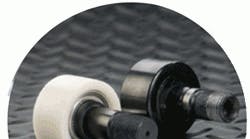Engineering design is an art of compromise. To achieve a design goal — for example, a certain machine function — engineers select components based on several criteria, including functionality, reliability, availability, cost, and lead times. Pros and cons are analyzed and a final selection made.
In the case of cam followers, it used to be that engineers had few choices beyond selecting the manufacturer. With no true options available, engineers were obliged to accept a host of costly features and operational limitations.
Traditional limitations
Whether the application calls for high or low load capacity, traditional cam design must provide for lubrication — either manually, or through a central lubrication system. Rail or cam surfaces must be hardened. During operation, lack of bearing or rail surface lubrication can lead to catastrophic failure. On the other hand, overgreasing can lead to product contamination, plus cam follower skidding, which in turn causes wear.
With traditional cams, shock and vibration can cause metal-to-metal impact, which in turn sheds metal particles. This tendency (plus the risk of grease contamination) often prevents equipment manufacturers from applying equipment containing cam followers in the growing cleanroom market.
Similarly, the relatively low rotating speed of traditional cam-follower needle bearings — and their steep rolling resistance and inertia — can be limiting factors in high-speed equipment design.
Another option: Composites
Now, metal cam follower disadvantages are eliminated with an alternative: Certain newer cams integrate a precision-machined outer tire made of thermoplastic composite.
When paired with two thermally installed roller bearings and a zinc-plated shaft with a corrosion-resistant coating, these cam followers help designers create trouble-free designs that can be applied in myriad environments. This is especially true in designs where the cam follower's primary function is to transmit motion, rather than supply high load-carrying capacity.
Dealbreaker: Load capacity
Despite their drawbacks, there are some extremely heavy applications for which metal cam followers are absolutely required. Considering the cost associated with design and operation of metal cam followers, it pays to understand the actual load carried in an application. With load data, including radial and axial forces, load duty cycle, and target linear speed, design engineers can use a plastic-roller life calculation to quickly assess whether an integrated composite cam follower can be used in a given application.
Load capacities of integrated composite cam followers are also listed on manufacturer web sites and represent the maximum load cam followers can safely carry for 100 million cycles, under both static and dynamic loads, without developing a flat or showing excessive wear. A consultation with the manufacturer's engineers may lead to alternative designs, eliminating wear and lubrication issues as well as minimizing machine design modifications.
For more information, call (201) 767-8066 or visit intechpower.com.
